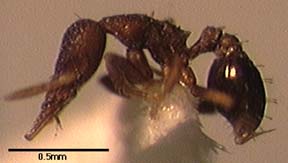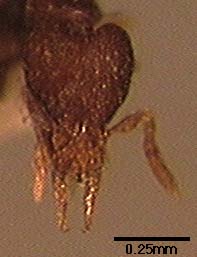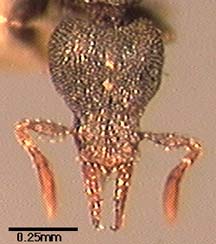Neostruma brevicornis (Mann 1922)
Formicidae, Hymenoptera, Insecta, Arthropoda, Animalia

Specimen: Costa Rica, Prov. Heredia: La Selva Biological Station, JTL1386-s, INBIOCRI001283872. Image by J. Longino.

Specimen: Costa Rica, Prov. Puntarenas: Monteverde, JTL1972-s, INBIOCRI001283888. Image by J. Longino.
Identification
Approximately 6 or fewer preapical denticles on mandible (not including basal), these gradually decreasing in size toward apex; propodeal suture moderately impressed; mesonotum with conspicuous pair of setae; total head length less than 0.95mm; color red-brown to dark brown.
Variation: this is a case where there is a larger, darker montane form (see discussion of montane dark forms). The light form has head length less than 0.75mm, and the mesonotal setae are usually spatulate and tilted forward. The dark form has head length 0.75-.090mm, and the mesonotal setae often relatively filiform, erect or tilted somewhat to rearward. To me they appear sympatric and largely discrete on the lower Atlantic slopes (50-800m). However, Bolton has examined these and other specimens and considers them to be one species (brevicornis). Also, Brown (1959) examined five Costa Rican collections of what he identified as N. brevicornis. One of the collections was from "Tablazo," a montane site, and was described as being dark brown rather than the lighter ferrugineous of other collections. He stated "The dark brown specimens (Tablazo) apparently come from a highland area in Costa Rica that has produced melanic variants of many wide-ranging dacetine species."
|

Specimen: Costa Rica, Prov. Heredia: La Selva Biological Station, JTL1386-s, INBIOCRI001283872. Image by J. Longino.

Specimen: Costa Rica, Prov. Puntarenas: Monteverde, JTL1972-s, INBIOCRI001283888. Image by J. Longino. |
Range
Costa Rica (both slopes from sea level to 2600m elevation), Honduras, Panama.
Natural History
Brown (1959) characterizes the genus as a whole as forming
"small colonies, chiefly in the leaf litter of rain forest or tropical evergreen forest, and nests occupy cavities in rotting twigs, pieces of bark or similar forest-floor vegetable debris... The food... consists primarily of small entomobryomorph Collembola and possibly some other minute terrestrial arthropods as well. Hunting behavior is like that of Smithistruma rather than like the Strumigenys so far studied."
This species inhabits wet forested habitats from near sea level to 2600m, the light form most abundant below 500m, the dark form most abundant above. It occurs in leaf litter and is common in Winkler samples. A Winkler sample from oak forest in the Talamancas (Cerro Gemelos) at 2600m yielded a few workers of this species and no other ants. This is one of the highest records of ants in Costa Rica (the only higher record I know is for a nomadic army ant, Labidus coecus, at 3000m near Villa Mills). At Monteverde the species is common in litter on the ground, but has also been taken in Winkler samples of epiphytes and soil from the forest canopy.
Selected Records (light form)
Winkler samples from La Selva Biological Station, Turrialba, Hitoy Cerere, Penas Blancas Valley (800m), Monteverde (900m elevation on road to Monteverde, moist forest remnant), Santa Rosa National Park ("Bosque Humedo"), Carara Biological Reserve, Manuel Antonio National Park, Corcovado National Park, 19km S. Ciudad Neily.
La Selva: nest in dead wood on forest floor.
Selected Records (dark form)
Winkler samples from the Talamancas (Cerro Gemelos and Estacion Biologica Pittier), San Vito area, Turrialba, Rara Avis, La Selva, Penas Blancas Valley, Monteverde, Guanacaste Conservation Area (Pitilla).
Literature Cited
Brown, W. L., Jr. 1959. A revision of the Dacetine ant genus Neostruma. Breviora 107:1-13.
John T. Longino, The Evergreen State College, Olympia WA 98505
USA.
longinoj@evergreen.edu
Last modified: 10 June 1997



